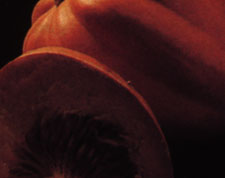

Butternut

FoodFood InformationVegetablesSquash
There are countless varieties of winter squash. While there are some
regional preferences for other varieties, the top three best sellers nationwide
are acorn, butternut, and Hubbard. Most winter squash, if
stored in a cool, dry, well-ventilated area, will have a shelf life of three
to four months. (Most summer squash have a shelf life of less than a week.)
In all winter squash varieties the seeds are too large and tough to be edible.
Seeds of some varieties are dried, then roasted, and are edible if the outer
husk is removed.
Winter squash no longer plays an important role in American cuisine. However,
back in Grandma's day, and especially in Great-grandma's day, it was a big
seller, because summer squash as well as most of the other fresh vegetables
were out of season during the winter and early spring. In that bygone era,
before butternut and acorn squash had yet to arrive on the scene in any
quantity, Hubbard squash played an all-important role.
The Hubbard is a large, hard as a rock, winter variety that can be
either dark green, light blue, or orange in skin color. The orange colored
flesh is flavorful and has a tender, string-free texture. It is usually
baked but can also be steamed or boiled. Its biggest shortcoming, and the
reason the Hubbard has gone out of vogue, is its large size. Hubbards usually
weigh from five to ten pounds, far too large for today's average family.
Prior to self-service, "green grocers" would cut a chunk of Hubbard
squash to order at the time of purchase. Today's usually under staffed self-service
supermarkets can't be bothered; they prefer to handle the smaller sized
acorn and butternut varieties.
The acorn is really a miniature version of the Hubbard squash. It has a
very hard-ridged rind, orange-colored flesh, and hard seeds that resemble
those found in a pumpkin. The outer skin is usually dark green in color
with a trace of small orange areas. Some varieties that are slate blue in
color have been phased out in deference to the public's preference for the
dark green color. Avoid acorn squash that are completely orange in
color; these are usually green ones that have matured and will be dry and
stringy in texture.
The ideal-sized acorn squash is large enough for two servings. Split
it in half, scoop out and discard the seeds, sprinkle some brown sugar in
the cavity, add a pat or two of butter, and bake it in the oven as you would
a potato. Since acorn squash is sometimes slightly stringy, you may wish
to remove it from the oven when it is soft. Mash the flesh with a fork and
rebake it for a few minutes. Some recipes call for stuffing the acorn with
ground meat or sausage. Baked acorn squash very similar to that of baked
sweet potatoes.
Use extreme caution when splitting an acorn squash. They are difficult to
cut and the knife may slip.
The butternut variety is a buff-colored winter squash. It is not
quite as hard as the acorn or the Hubbard but it is hard. In shape it looks
somewhat like a thick-necked bowling pin. Butternut may be baked in the
half-shell like acorn squash, but it is usually cut into pieces, steamed
or boiled, and then mashed. The butternut won't be as difficult or as dangerous
to cut as the acorn. It is the easiest winter squash to prepare and is second
to none in fine flavor and smooth, string-free texture.
Both acorn and butternut squash are available year-round, but those sold
in the fall and winter are usually of better quality than those that are
in market in the spring and summer.
Chayotes are available twelve months a year and require refrigeration. Supplies
of other squash are erratic and limited; these other squash should be refrigerated
if temperatures exceed 70°F.
Except perhaps for Marrow squash, as far as flavor and texture are concerned,
none of these varieties is superior to, and some aren't nearly as good as,
the more readily available, far less costly butternut squash. However, as
they gain popularity and become better known, supplies will increase, more
stores will handle them, and prices will ease.



Deamer 5/97